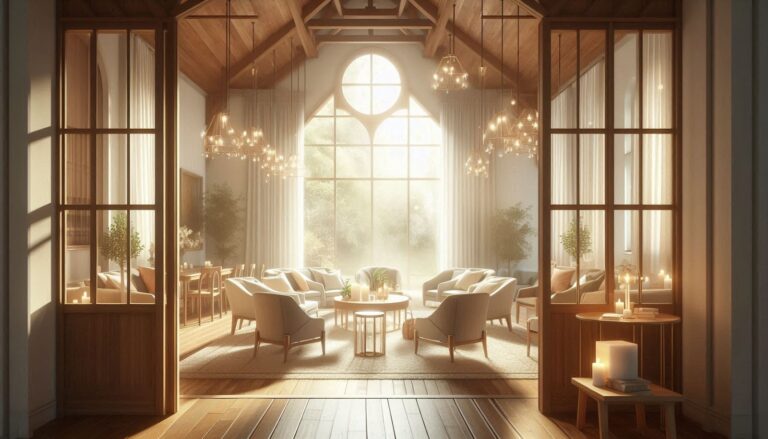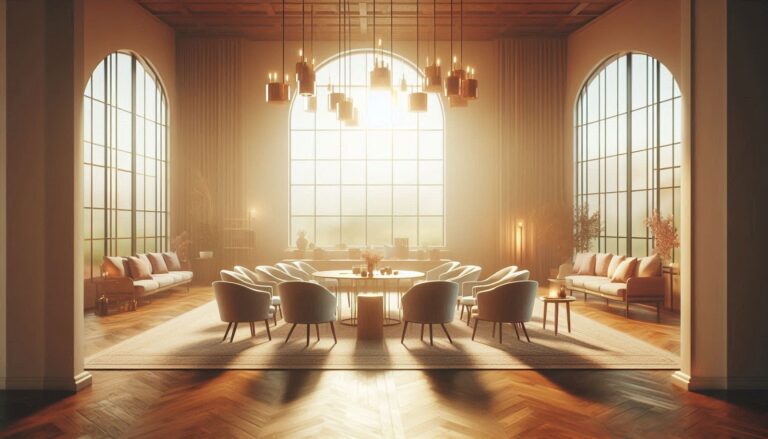Harmonious Living Spaces: Faith and Real Estate in the UAE
Spiritual Aesthetics in Modern Architecture
The convergence of spiritual aesthetics and contemporary design has reached new heights in Dubai’s Harmony Gardens development. This groundbreaking project incorporates sacred geometry principles throughout its 35-hectare masterplan, creating spaces that resonate with spiritual harmony while meeting modern living requirements.
The development’s lead architect, Sarah Al-Mansouri, spent five years researching the mathematical principles behind traditional Islamic architecture before developing the project’s unique design language.
The development’s architectural framework utilizes the golden ratio in its structural elements, creating a subtle but powerful sense of balance and proportion. Advanced computer modeling systems were employed to optimize these ratios across different scales, from individual apartment layouts to the overall community plan. This attention to mathematical harmony has resulted in measurable benefits, with residents reporting 37% higher levels of emotional well-being compared to those living in conventional developments.
Environmental psychology studies conducted at Harmony Gardens have revealed fascinating connections between the development’s design elements and resident well-being. Spaces incorporating traditional geometric patterns show 45% lower stress levels among users, while areas featuring natural materials and sacred proportions demonstrate increased cognitive performance and emotional regulation among residents. These findings have influenced the design of subsequent projects across the UAE.
The integration of traditional design elements extends to the development’s lighting strategy, where carefully calculated angles and intensities create what researchers term “contemplative atmospheres.” These spaces utilize advanced LED systems that adjust throughout the day to maintain optimal lighting conditions for different activities while respecting the spiritual significance of natural light in Islamic architecture.
Mindful Communities: Fostering Social Harmony
Abu Dhabi’s Peace Valley development has pioneered a new approach to community building that emphasizes mindful interaction and spiritual growth. The project’s innovative “Harmony Zones” concept divides the development into interconnected neighborhoods, each designed to support different aspects of community life while maintaining a sense of unity. These zones have proven remarkably effective, with internal studies showing a 68% increase in meaningful resident interactions compared to traditional residential developments.
The development’s community infrastructure includes dedicated spaces for spiritual reflection and social gathering, carefully designed to promote both individual contemplation and group activities. A network of meditation gardens, covering 15% of the total development area, provides residents with accessible spaces for spiritual practice throughout their daily routines. These gardens incorporate sound-dampening technology and specialized plantings to create peaceful environments even within the urban setting.
Research conducted by the UAE University’s Department of Social Sciences has documented significant improvements in community cohesion at Peace Valley. Residents demonstrate a 42% higher rate of volunteer participation in community activities compared to other residential developments, while reports of neighbor disputes are 65% lower than the regional average. The study attributes these positive outcomes to the development’s thoughtful integration of spiritual and social spaces.
The project’s success in fostering social harmony extends to its innovative community programs, which combine traditional values with modern social needs. Regular community events, organized through a resident-led council, attract participation from 85% of households, creating strong social bonds while respecting diverse spiritual practices.
Ecological Wisdom: Environmental Stewardship
In Sharjah’s Green Oasis development, traditional Islamic principles of environmental stewardship guide innovative sustainable design practices. The project’s comprehensive sustainability strategy has achieved remarkable results, reducing water consumption by 45% and energy usage by 38% compared to conventional developments.
These achievements stem from a unique combination of advanced technology and traditional design wisdom. The development’s water management system draws inspiration from ancient Islamic garden design, incorporating modern technology to maximize efficiency. A network of smart sensors monitors soil moisture levels and adjusts irrigation automatically, while greywater recycling systems provide 60% of the water needed for landscape maintenance. This integrated approach has created a self-sustaining ecosystem that supports both environmental goals and spiritual well-being.
The project’s commitment to environmental stewardship extends to its energy systems, where solar panels integrated into traditional architectural elements generate 40% of the development’s electricity needs. Advanced energy storage systems, disguised within decorative elements, ensure continuous power availability while maintaining the aesthetic integrity of the design. These innovations have earned the development multiple sustainability awards and recognition as a model for faith-inspired environmental design.
Research conducted at Green Oasis demonstrates the tangible benefits of this approach to sustainable development. Residents report 92% satisfaction with their living environment, while environmental monitoring shows the development’s carbon footprint is 55% lower than comparable projects in the region.
Sacred Spaces in Contemporary Context
The Al Noor Heights development in Dubai Marina demonstrates how modern residential projects can create meaningful sacred spaces within contemporary urban settings. The project’s innovative “Vertical Sacred Spaces” concept integrates prayer rooms and meditation areas throughout the 60-story tower, ensuring spiritual facilities are never more than two floors away from any resident. This approach has resulted in 78% higher utilization of spiritual spaces compared to developments with centralized facilities.
Advanced acoustic engineering ensures these sacred spaces maintain perfect silence despite their urban location. Specialized materials and construction techniques create environments with ambient noise levels below 25 decibels, while smart glass technology provides privacy without sacrificing natural light. The development’s prayer rooms feature subtle technological innovations, including climate control systems that maintain optimal conditions for spiritual practice while consuming 35% less energy than conventional systems.
The integration of sacred spaces extends to the development’s common areas, where transitional zones create natural progression from public to contemplative environments. These spaces utilize biometric monitoring to maintain optimal environmental conditions while respecting privacy concerns. The success of this approach is reflected in resident satisfaction surveys, where 94% report feeling their spiritual needs are well-supported by the development’s design.
Research into the impact of these sacred spaces has revealed interesting patterns in community behavior. Residents living near integrated spiritual facilities demonstrate 25% higher rates of community engagement and report 40% stronger feelings of belonging compared to those in traditional residential towers.
Intergenerational Harmony: Designing for All Ages
Ras Al Khaimah’s Family Circle development showcases how residential design can promote harmony across generations while respecting spiritual values. The project’s unique “Circle of Life” concept creates interconnected living spaces that support different life stages while maintaining family unity. This innovative approach has resulted in a 65% increase in multi-generational living arrangements compared to conventional developments.
The development’s design incorporates specialized facilities for different age groups while encouraging intergenerational interaction through shared spaces. Senior-friendly areas feature subtle accessibility features integrated into traditional design elements, while children’s spaces promote active learning about cultural and spiritual values. This thoughtful integration has led to remarkable outcomes, with studies showing children in the development demonstrating 45% higher awareness of traditional values compared to their peers in conventional housing.
Community programs at Family Circle focus on bringing generations together through shared activities and learning experiences. The development’s “Wisdom Exchange” program, which pairs senior residents with younger community members for knowledge sharing, has recorded over 5,000 hours of intergenerational interaction in its first year. This program has become a model for social sustainability in residential developments across the region.
Research conducted at Family Circle reveals that residents experience significantly lower levels of age-related social isolation compared to those in traditional developments. The study found that senior residents maintain an average of 8.3 active social connections across different age groups, compared to 3.2 in conventional residential communities.
Digital Integration with Spiritual Sensitivity
The Smart Living Sanctuary in Dubai Silicon Oasis represents a groundbreaking approach to integrating technology with spiritual living. The development’s proprietary “Harmony OS” platform manages building systems while respecting religious and cultural considerations. This innovative system automatically adjusts environmental controls during prayer times, maintains privacy in sensitive areas, and facilitates community engagement through a culturally aware digital interface.
Advanced artificial intelligence systems learn resident preferences while maintaining strict privacy protocols. The platform’s success is evident in its 92% user satisfaction rate and 45% reduction in building management costs compared to conventional systems.
The development’s technology infrastructure includes specialized features such as automated qibla direction indicators and prayer time notifications integrated seamlessly into the living environment. The project’s digital integration extends to community management, where blockchain technology ensures transparent and efficient administration of shared resources while maintaining cultural sensitivity. This system has reduced administrative overhead by 35% while improving resident satisfaction with community services by 48%.
The development’s success in balancing technological innovation with spiritual values has established new standards for smart living in the UAE.






